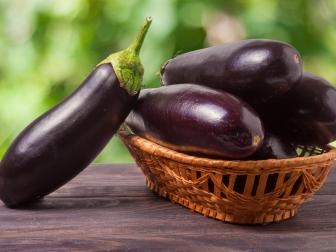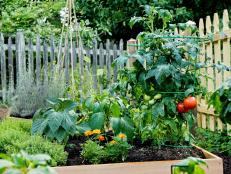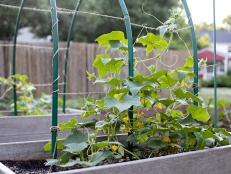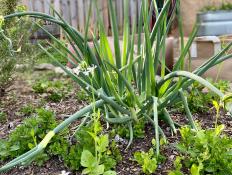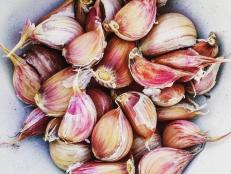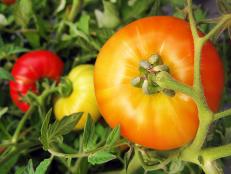Companion Planting for Eggplant
One of the most beautiful vegetable garden plants, eggplant can be plagued by pests like flea beetles. Try companion planting techniques to protect your eggplant crop.

Glossy and glamorous eggplant fruit are both delicious and ornamental. There are many varieties of this exotic-looking fruit that vary in shape, size, and color, from the traditional large, bell-shaped fruits, to elongated Asian types, to small, egg-shaped fruits. Colors range from the deepest purples and speckled lavenders to bright white and even green. Eggplant is tasty baked, grilled, fried, pickled, roasted, sautéed, stuffed … the list goes on.
Unfortunately, eggplant is plagued by annoying pests that can seriously damage plants and discourage gardeners from cultivating this versatile vegetable. To keep your eggplant healthy and productive, follow the best practices for growing and experiment with companion planting.
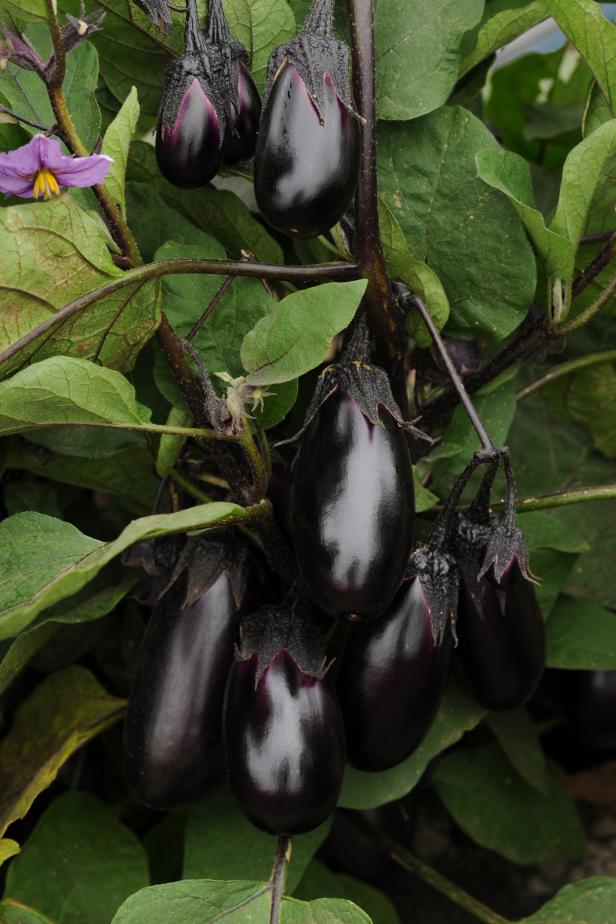
Ball Horticultural Company
Eggplant ‘Patio Baby’ produces small, dark purple fruits early in the season and bears all summer. The plants top out at 16-20” high, so they’re ideal for containers or small gardens. In eggplants, the antioxidants are found in the skins, which are best eaten when the fruits are young. Later, the skins become tough and bitter.
What is Companion Planting?
Growing a diversity of vegetables, herbs, and flowers can improve the health of your veggie plot by supporting the garden ecosystem. Simply growing more than a few species of crop plants goes a long way in deterring pests — usually by masking vegetables either visually or camouflaging with fragrance.
Flowering insectary plants attract beneficial insects like pollinators and predators of pests. Boosting pollinator populations means that more eggplant flowers will be visited by buzzing bees, which can improve fruit quality and yield.
Cover crops serve as banker plants by providing food and habitat for beneficial organisms both above and below the soil. Gardeners who avoid tilling can cut back cover crops before they go to seed and leave the cuttings on the soil surface as a weed-suppressing mulch that also provides habitat for beneficial insects and spiders.
Trap crops are more attractive to pests than your preferred vegetables. Big gardens can intercept pests by surrounding the eggplant plot with a trap crop. Smaller gardens can set aside a row or section of the garden for the trap crop. Remove pests from the trap crop to prevent them from spreading to your eggplant. Larger pests, like the Colorado potato beetle, can be picked off and dropped into a bucket of soapy water. Use an old vacuum cleaner to capture tiny pests like flea beetles.
Eggplant Companions
To Improve Growth
- Cultivate garlic with eggplant to build soil organic matter and make important nutrients, like nitrogen, phosphorus, and potassium, more accessible.
- Grow eggplant after a cover crop of hairy vetch to boost nutrient availability in the soil, improve fruit quality, and even increase yields. For best results, cut back the vetch and leave residues on the soil surface as a mulch before planting eggplant seedlings.
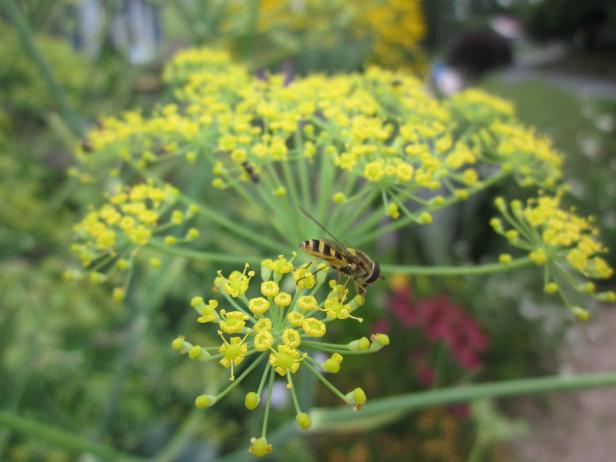
Julie Martens Forney
Dill is a helpful plant in the vegetable garden because its small flowers attract beneficial insects, including hoverflies and ladybugs (both prey on aphids), wasps of all sorts (prey on caterpillars and other insects), spiders and pollinating bees. Other good dill companions: cabbage, onion, cucumber, corn, eggplant, and lettuce.
To Attract Beneficial Insects
- Members of the bean family — including snapdragons, lupines, peas, and beans — have “hooded” flowers that bumblebees adore. Buzzing bumblebees are highly efficient at pollinating solanaceous plants like eggplants, tomatoes, and peppers, which means that attracting these pollinators to the garden may improve your harvest.
- Interplant open-flowered herbs from the carrot family — like dill and cilantro — to attract predators of the Colorado potato beetle, including lacewings, coccinellid beetles, and spotted lady beetles.
- Grow eggplant after a cover crop of crimson clover to discourage pests and invite predators. This practice may not result in higher yields, but research suggests that plants will be larger and healthier, with less damage from pests like flea beetles and the Colorado potato beetle. For best results, till the clover into the soil where eggplant will grow and leave a strip of fading clover outside of the row. Mow the crimson clover after it blooms to prevent it from re-seeding.
To Lure Away Pests
- Growing a lot of eggplant? Try planting a sacrificial trap crop of long-fruited Japanese or Italian type eggplant (like the variety ‘Vittoria’) around the perimeter of the plot. Some evidence suggests that pests like the Colorado potato beetle and the eggplant flea beetle prefer these types of eggplant. Be sure to remove the pests before they’re able to spread to the main crop. Tip: Some gardeners like to use an old vacuum cleaner to capture tiny pests like flea beetles. A battery operated hand-held vacuum should do the trick for catching flea beetles, although a wet/dry vac or the hose attachment on a traditional vacuum cleaner should do the trick as well. To prevent further injury to the plant, avoid vacuuming pests from seedlings.
Tips for Growing Eggplant
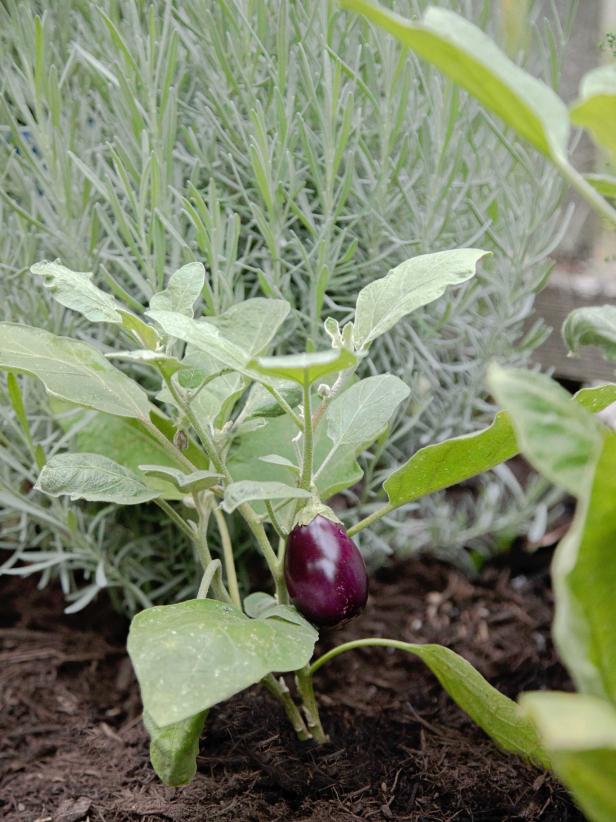
SHAIN RIEVLEY
Give eggplant a head start on the season by sowing seed indoors 8 to 10 weeks before the last frost or by purchasing healthy, vigorous seedlings from your local garden center. If you opt to start plants from seed, eggplant seedlings need sunlight and warmth to thrive, which means that a good grow light and heat mat would be wise investments. Seedlings should be ready to move into the garden after the danger of frost has passed and when nighttime temperatures are consistently above 50 degrees Fahrenheit.
Transplant eggplant seedlings instead of sowing seed directly in the garden to give the crop a better chance of survival. Voracious pests — especially the eggplant flea beetle — can defoliate baby eggplants in a flash. If eggplant or potato flea beetles (Epitrix fuscula and E. cucumeris) are problems in your garden, consider using a row cover or netting for individual plants until they are large enough to cope with some pest damage. Don’t panic if cruciferous cool-season veggies like broccoli, cabbage, or turnips have been plagued by flea beetles in your garden. Flea beetles that feed on brassicas are in a different genus (Phyllotreta spp. or Systena blanda) and shouldn’t be a problem for eggplant.
Eggplant will grow happily in full sun (six or more hours a day) with rich, well-drained soil. Improve the soil by amending with compost or manure before planting. For a nice, bushy plant, pinch the top bud when the plant is about 10 inches tall. Give eggplant a little support from a tomato cage or stakes. Shiny, fully colored fruits are ready to harvest. Use hand pruners or snips to remove the eggplant by cutting the stem about an inch above the fruit.
How to Freeze Eggplant
Homegrown eggplant is delicious, with so many uses in the kitchen. When you have more than you can eat, learn how to freeze eggplant for later use.
Tips for Crop Rotation
- It’s a good idea to grow eggplant with its solanaceous relatives, including tomatoes, peppers, and tomatoes, and move them to a new area of the garden each season. These plants are often susceptible to the same pests and diseases. Rotate where these crops are grown to prevent pests and diseases from building up in the soil.
- Eggplants and other nightshades grow best with plenty of nitrogen. Rhizobium bacteria that live in the roots of beans, peas, and other legumes fix nitrogen from the atmosphere and make it available in the soil for other plants to use. Solanaceous crops love to follow legumes in a crop rotation schedule.






